
The Tasmanian temperate rain forests are a temperate broadleaf and mixed forests ecoregion in western Tasmania. The ecoregion is part of the Australasian realm, which includes Tasmania and Australia, New Zealand, New Guinea, New Caledonia, and adjacent islands.

The Atherospermataceae, commonly known as the southern sassafrases, are a family of broadleaf evergreen trees and shrubs. The family includes 14 species in seven genera. The atherosperms are today mostly distributed in the Southern Hemisphere, with two species native to southern Chile and 12 species native to Australasia. Wood is commercially harvested from rainforest species of this family, and is used both in construction and in fine cabinet making.

The Styx Valley is a valley located adjacent to the Tasmanian Wilderness World Heritage Area on the island of Tasmania, Australia. The Styx River is the main drainage system of the valley that lies about 100 kilometres (62 mi) northwest of Hobart, with the nearest town being Maydena.

Doryphora is a genus of 2 species of flowering plants in the family Atherospermataceae that are endemic to Australia. Plants in the genus Doryphora are medium-sized to tall trees with glabrous, leathery, sometimes serrated leaves, and flowers usually arranged in groups of 3, each flower with both make and female parts, usually 4 or 6 tepals, 6 stamens and 6 to 12 carpels.
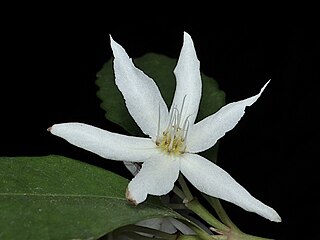
Doryphora sassafras, commonly known as sassafras, yellow sassafras, golden deal or golden sassafras, is a species of flowering plant in the Southern Sassafras Family Atherospermataceae and is endemic to eastern Australia. It is a shrub to tree with elliptic or egg-shaped leaves and contrasting white flowers which occur in autumn and winter.

Elaeocarpus holopetalus, commonly known as black olive berry, mountain blueberry, or mountain quandong, is species of flowering plant in the family Elaeocarpaceae and is endemic to eastern Australia. It is a shrub or small tree with regularly toothed, lance-shaped to egg-shaped leaves, racemes of white flowers and black, oval fruit.

Daphnandra johnsonii, also known as the Illawarra socketwood, is a rare rainforest tree in the Illawarra district of eastern Australia.
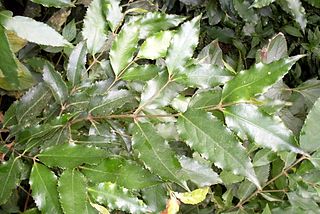
Daphnandra apatela, the socketwood, light yellowwood or canary socketwood is a common rainforest tree in eastern Australia. It grows in the more fertile alluvial soils and basaltic soils. Distributed from the Watagan Mountains in New South Wales to Miriam Vale near Gladstone in Queensland.

Daphnandra micrantha, known as socketwood or Manning River socketwood, is a rainforest tree in eastern Australia. It grows near streams in various types of rainforest, and is also seen in ecotone areas dominated by brush box and tallowwood. It is restricted to the Manning and Hastings River valleys of New South Wales.

Wilkiea is a genus of flowering plants in the family Monimiaceae, and is native to Australia and New Guinea. Plants in this genus are monoecious or sometimes dioecious trees and shrubs, the leaves with many fine oil dots, male and female flowers in cymes or panicles, and oval black drupes.

Atherosperma moschatum subsp. integrifolium, commonly known as southern sassafras, narrow leaf sassafras or blackheart sassafras, is a flowering plant in the family Atherospermataceae and is endemic to New South Wales. It is a slender shrub or small tree with mostly lance-shaped leaves, white flowers and the fruit an achene.

Palmeria foremanii, commonly known as anchor vine, is a species of flowering plant in the family Monimiaceae and is endemic to an area near the New South Wales - Queensland border. It is a tall, woody climber or scrambling shrub with usually elliptic leaves, male and female flowers on separate plants with 5 tepals, male flowers with 40 to 43 stamens, female flowers with 7 to 12 carpels, and spherical, shiny black drupes.

Wilkiea cordata is a species of flowering plant in the family Monimiaceae, and is endemic to north-east Queensland. It is a shrub or small tree with oblong leaves, male and female flowers on separate plants, male flowers with stamens in 2 pairs, female flowers with about 25 carpels, and the fruit is an oval drupe with a yellow receptacle with an orange tinge.
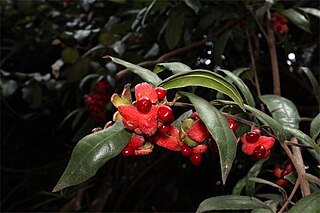
Palmeria racemosa is a species of flowering plant in the family Monimiaceae and is endemic to eastern Australia. It is a woody vine with elliptic to oblong leaves and male and female flowers borne on separate plants, male flowers usually with thirty to forty stamens and female flowers with about ten carpels. The fruit is green, splitting to form a pinkish receptacle with 3 to 7 black or red drupes.
Wilkiea hugeliana is a species of flowering plant in the family Monimiaceae, and is endemic to Cape York Peninsula in far northern Queensland. It is a shrub or small tree with elliptic, sometimes toothed leaves, and male and female flowers on separate plants. Male flowers usually have 4 pairs of stamens and female flowers have about 40 carpels, and the fruit is a glossy black drupe with enlarged orange receptacles.

Doryphora aromatica, commonly known as sassafras, northern sassafras, northern grey sassafras, net sassafras or grey sassafras, is a species of flowering plant in the Southern Sassafras Family Atherospermataceae and is endemic to north-east Queensland. It is a tree with elliptic or egg-shaped leaves with the narrower end towards the base, white flowers with 5 stamens and 6 to 8 carpels, and achenes splitting to release feather-like fruits.
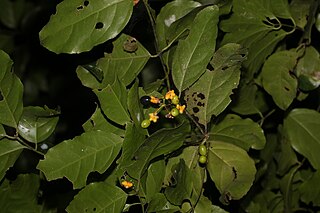
Wilkiea longipes is a species of flowering plant in the family Monimiaceae, and is endemic to northern Queensland. It is a shrub or small tree with elliptic to egg-shaped leaves with the narrower end towards the base, and male and female flowers on separate plants. Male flowers usually have 3 or 4 pairs of stamens and female flowers have about 9 to 13 carpels.

Wilkiea pubescens is a species of flowering plant in the family Monimiaceae, and is endemic to north Queensland. It is a shrub or small tree with elliptic leaves and male and female flowers on separate plants. Male flowers have 6 tepals and 2 or 3 pairs of stamens and female flowers have 2 pairs of tepals and 15 to 30 carpels. The fruit is a purplish-black drupe.
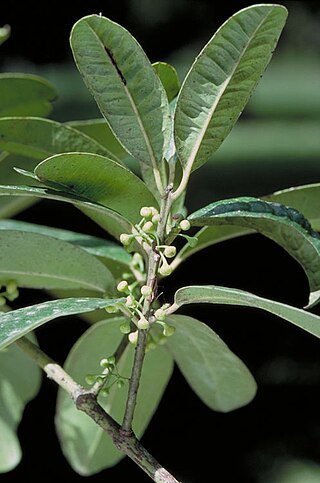
Wilkiea rigidifolia is a species of flowering plant in the family Monimiaceae, and is native to north Queensland and New Guinea. It is a shrub or small tree with elliptic to broadly elliptic or oblong leaves and male and female flowers on separate plants. Male flowers are borne in clusters of 20 to 30 and have 4 pairs of tepals and 2 or 3 pairs of stamens and female flowers have 2 pairs of tepals and 40 to 50 carpels. The fruit is a glossy black drupe.
Wilkiea smithii is a species of flowering plant in the family Monimiaceae, and is endemic to north-eastern Queensland. It is a shrub or small, slender tree with elliptic or oblong leaves and male and female flowers on separate plants. Male flowers are borne in clusters of about 5 and have 8 tepals and 2 pairs of stamens and female flowers have 20 to 40 carpels. The fruit is a glaucous, purplish to black drupe.


















